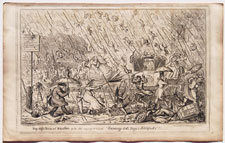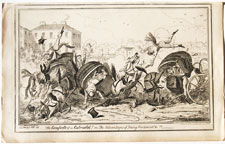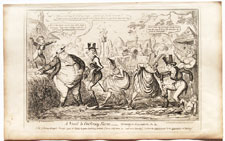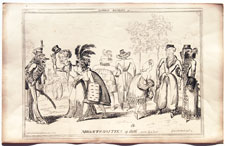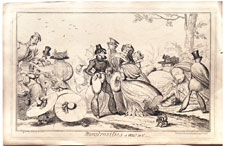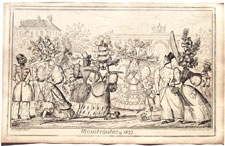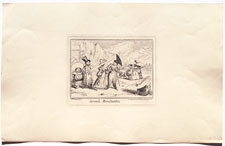Isaac Robert (1786-1856)
Caricaturist, illustrator and miniature painter.
He was born in 1786, the eldest son of Isaac Cruikshank and brother of George Cruikshank, Sr.. He served as midshipman with the East India Company until 1814, setting up as a miniature painter in London and changing to etching and caricatures in 1816. Between then and 1825 he attained almost as wide a popularity as his brother, issuing caricatures on the follies of fashion, the foibles of military life and those of the stage.
He achieved great success with the illustrations for Life in London, the book adapted from the play which he had himself designed at the Adephi Theatre. He also provided lively and well-executed illustrations for The English Spy, but after the 1820s he dropped out of favour and published slovenly uneven work. Everitt considers that the new forms of caricature adopted by JB and others killed his not very original talent.
He died in poverty, 13 March, 1856.
George, Sr.
Artist, etcher and polemicist on temperance, caricaturist.
Born at Duke Street, Bloomsbury, on 27 September, 1792, the second son of the caricaturist, Isaac Cruikshank. He worked with his father from an early age, engraving lottery tickets and chapbooks, his first published design appearing in 1806.
From his father's death in about 1810, he developed as the foremost political caricaturist of the Regency, both spiritually and physically taking over the place of the insane Gillray at Mrs. Humphrey's establishment. As early as 1820 when the caricature boom was still at its zenith, Cruikshank had begun contributing to ephemeral journals like The Wits' Magazine and was establishing himself as a book illustrator.
His first major work in this medium was the Regency best-seller Life in London, by Pierce Egan. This was followed by similar publications, including Life in Paris, and then a number of smaller books which became little more than vehicles for his own lively drawings. By the 1830s he was the leading illustrator and was engaged on works by Charles Dickens, Harrison Ainsworth and Sir Walter Scott. At the same time yearly almanacks were issued from 1835 to 1853 under the artist's name and these were succeeded by George Cruikshank's Magazine, 1853-1854.
Cruikshank's conversion to the teetotal cause in the late 1840s gave him fresh zest for life at exactly the moment when his fame was starting to diminish. The next thirty years witnessed an incredible activity from his pen, mostly for the Temperence League and including his mammoth The Worship of Bacchus, the vast unmanageable canvas which took him three years to complete and is now relegated to the cellars of The Tate Gallery. This frenzied picture, with its hundreds of tiny figure groups in various stages of dissipation says a great deal about the artist. Strongly inventive and with a keen eye for the absurd and the pathetic, he had delusions of grandeur which were unsuited to his small scale genius. Although Ruskin gave him fulsome praise for his children's books, the vigour of his line and bombast of his humour belonged to the 18th century rather than the 19th.
Cruikshank died at Mornington Crescent on 1 February, 1878 and was buried at Kensai Green; his body was later removed to St. Paul's at the instigation of the temperance lobby rather than for his acknowledged importance as an artist.
Finished drawings by the artist are rare, the most common items met with are pencil studies in small scale on white paper, the major figures drawn over n ink in preparation for the completed work.
George, Jr. (1866-1894)
Son of George Cruikshank (q.v.). His drawings are very weak imitations of his father, he contributed to magazines in the 1870s and 1880s and usually signs George Cruikshank Junior.
[The Dictionary of British Book Illustrators and Caricaturists, 1800-1914 by Simon Houfe.]





